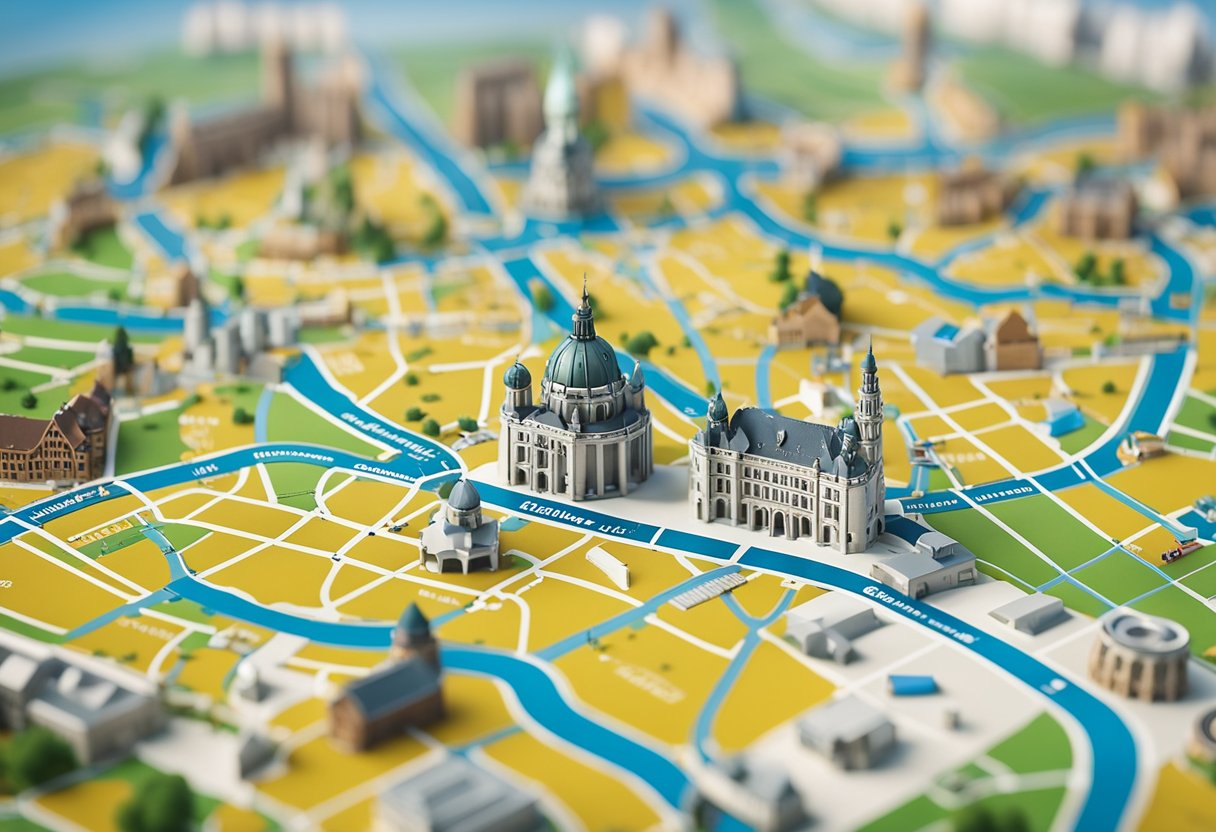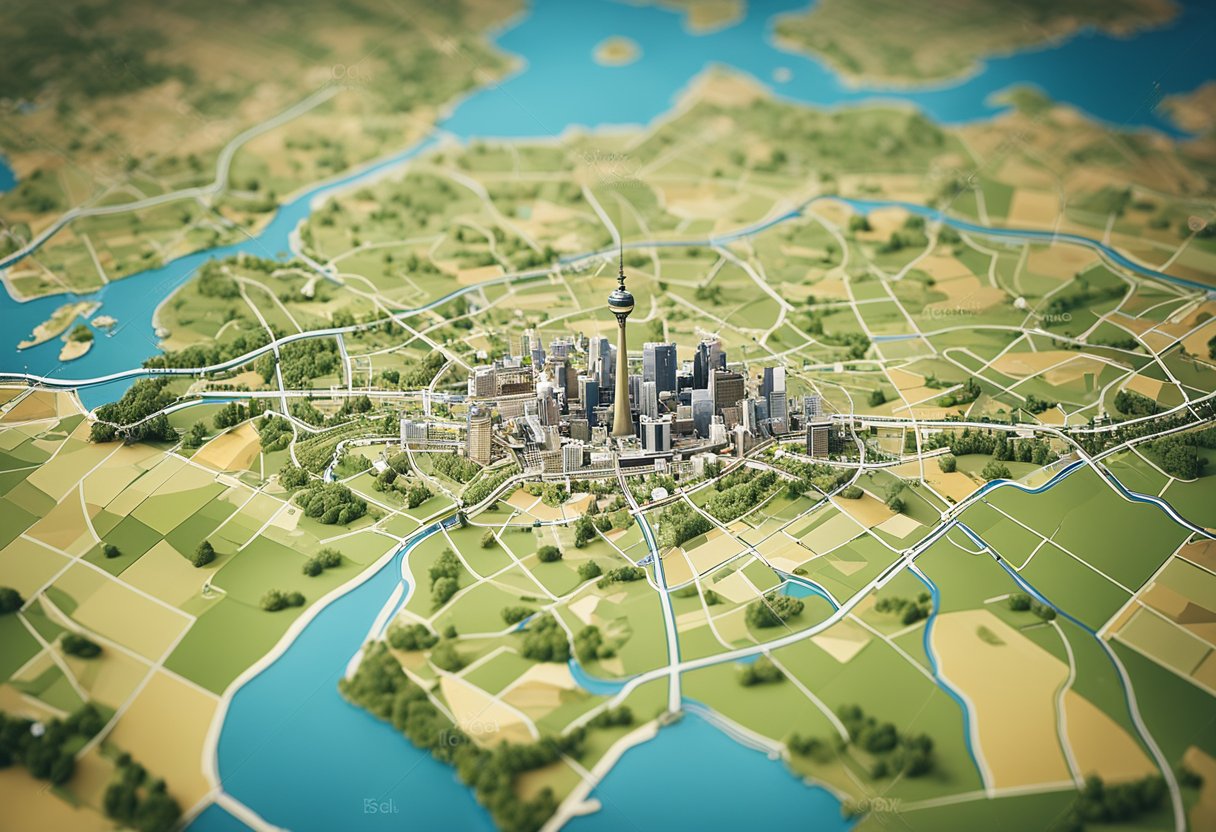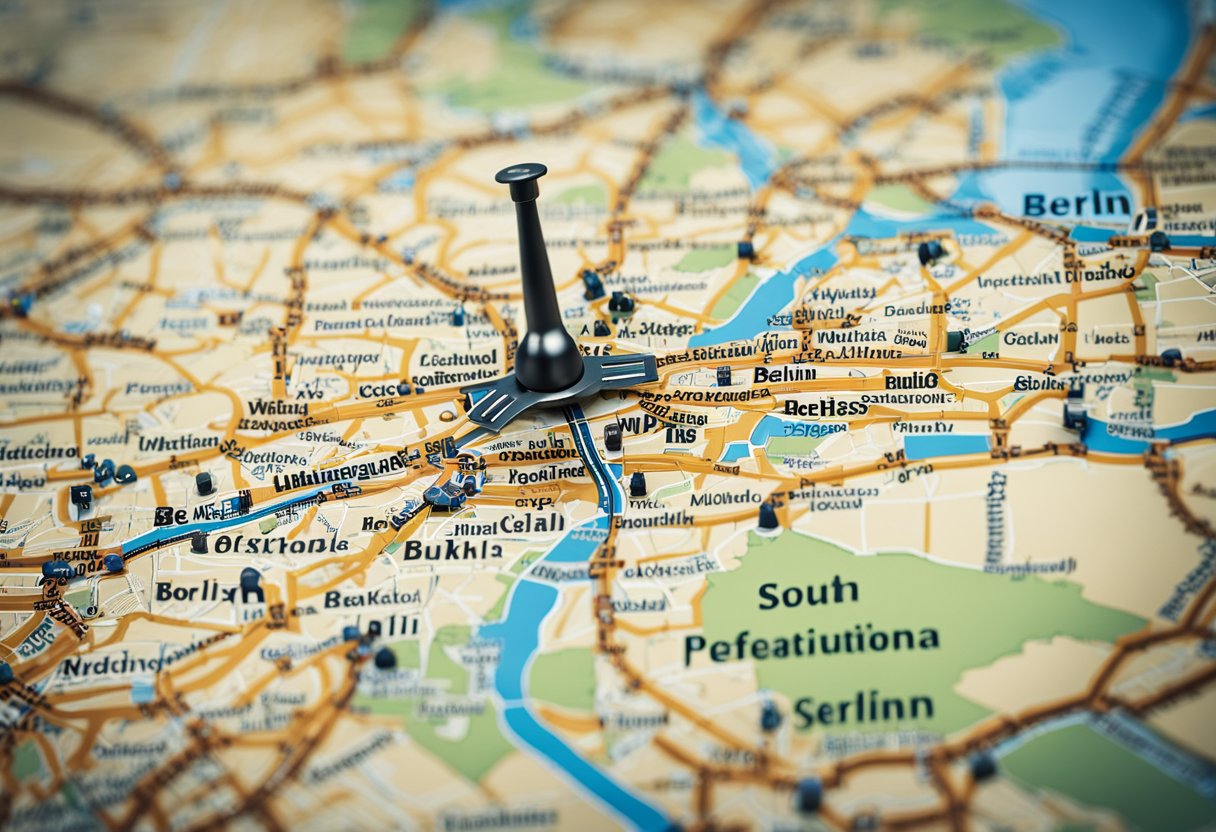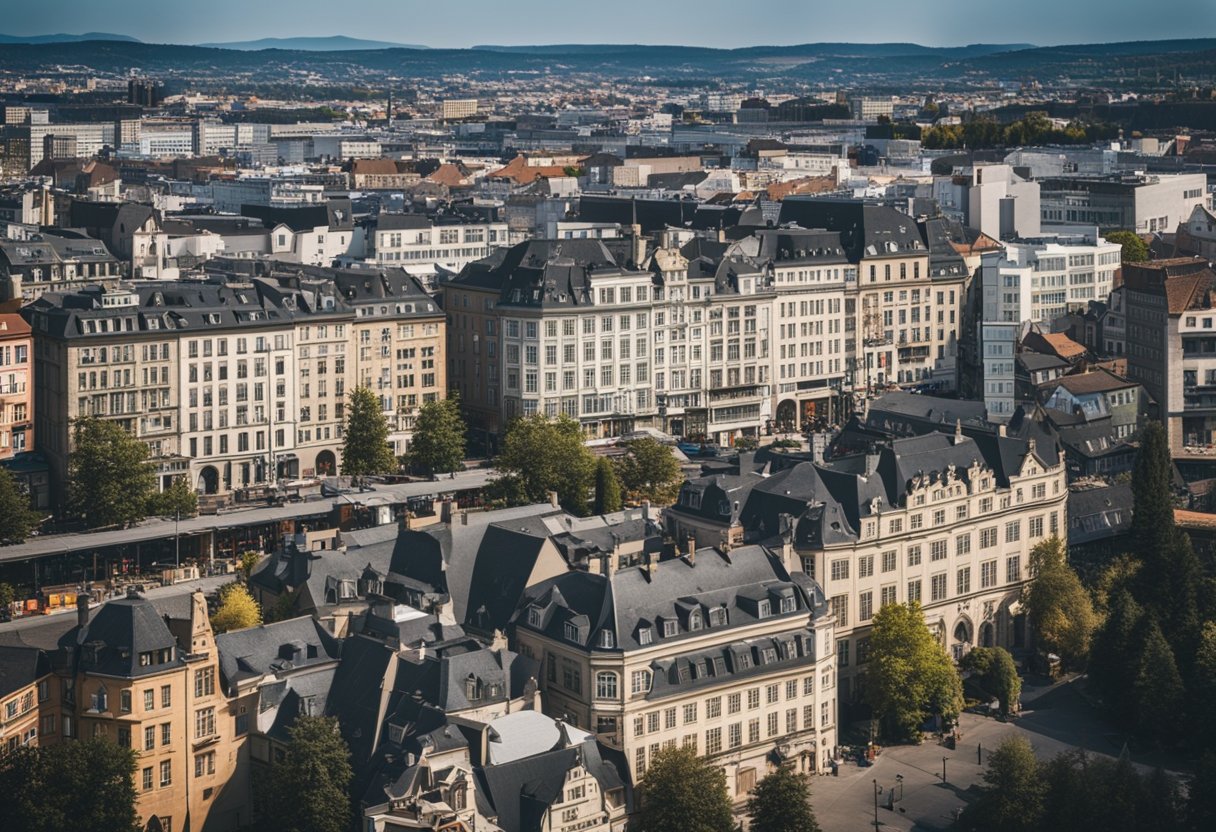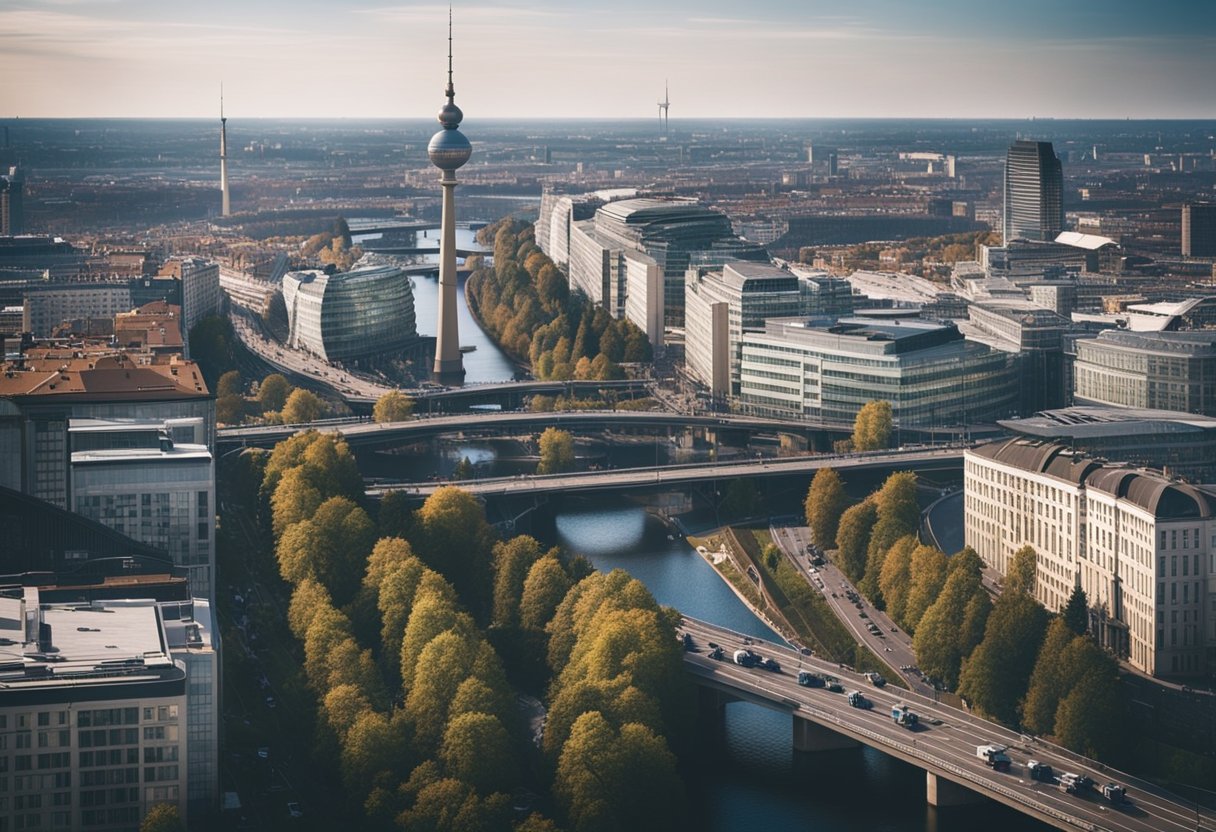The capital city Germany, Berlin North or south Germany? This perfectly sits at a significant geographical crossroads that has historically influenced its development and standing in the country.
Geographically, Berlin is positioned in the northeastern part of Germany, making it a central location within the North German Plain.
It is well to the north of the traditional north-south divide in Germany, which is sometimes considered to run just south of Frankfurt. This places Berlin in the northern region of the country, a fact reflected in its climate, culture, and historical ties with the northern German states.
The question of whether Berlin is considered northern or southern Germany may arise from a broader perspective of cultural and political distinctions within the country.
However, by strict geographical standards, Berlin’s location is clearly in the northern half of Germany. The city is surrounded by the State of Brandenburg, with the capital Potsdam being nearby.
This proximity to the northern border and to other northern German cities reinforces Berlin’s classification as a part of northern Germany, despite being relatively central on the longitudinal axis.
Determining Berlin’s orientation within Germany not only involves understanding its physical location but also taking into account the historical context that influences perceptions of the city’s geographical identity.
Regardless of the interpretative lens used, Berlin is, without doubt, situated in the northern part of Germany, anchoring its identity firmly within the northern German landscape.
Geographic Overview of Germany- Berlin North or South Germany?
Germany, situated in the heart of Central Europe, boasts a significant geographical stature with its capital, Berlin, located towards the northeastern part of the country.
Encompassing an array of topographical features and a distinctive division between the north and south, Germany’s landscape offers a rich tapestry of natural sites.
Germany’s Location in Europe
Germany anchors itself firmly in Central Europe, touching the Baltic and North Seas to the north.
At the coordinates of approximately 51° to 55° N latitude, it is quite distant from the equator, ensuring a temperate seasonal climate rather than extreme weather. Berlin, the German capital, is situated at roughly 52.52° N, 13.40° E, placing it well within the northern half of Germany.
Topographical Distinctions
Germany’s topography is notably varied, with the North German Plain characterized by low-lying, flat terrain that graduates to the hilly central uplands and reaches the Alps in the far south.
This diverse topography sharply contrasts with Berlin’s predominantly flat landscape, which melds into the expansive Northern European Plain.
Dividing Germany: North and South
The conceptual division of North and South Germany is often based on cultural, historical, and geographic lines rather than strict administrative borders. While Berlin is not in southern Germany, it historically and culturally aligns more with northern traits.
It is significantly closer to the Baltic Sea than to the geographical midpoint of Germany, positioning it firmly in the northeast region of the country. Berlin’s area extends over roughly 891 square kilometers, reinforcing its standing as an epicenter for cultural and political influence in northern Germany.
Historical Context
To understand Berlin’s geographical and political place within Germany, it’s crucial to consider the city’s historical evolution within the broader context of Germanic history. This perspective sheds light on whether Berlin is historically categorized as part of northern or southern Germany.
Formation of German States
Berlin’s roots trace back to the times when Germany was a tapestry of various states and principalities. Following the decline of the Roman Empire, the region saw a fragmentation into numerous territories. By the early Middle Ages, distinct German states had emerged, laying the groundwork for future centralization.
From Prussia to Modern Germany
The Kingdom of Prussia began to exert its influence in the early 18th century, with Berlin at its core. Prussia’s power expanded, forming the nucleus of what would become the German Empire in 1871.
The shift from a disconnected array of kingdoms to a unified nation established Berlin as a central player in German affairs. After the catastrophic impacts of World War II, Germany was divided into East and West, with Berlin symbolically and physically split by the Berlin Wall.
Berlin’s Unique Historical Position
The city’s strategic position made it a pivot between western and eastern Europe. As a result, Berlin was not just a German epicenter but also a focal point for continental interactions.
Following the fall of the Berlin Wall in 1989 and the subsequent unification of East and West Germany in 1990, Berlin reinstated its role as the capital of a unified Germany.
Its position remained solidified within the northern part of the country, adjacent to the North German Plain, aligning with the historical evolution of German political geography.
Political and Administrative Structure
Germany’s federal system is comprised of states known as Bundesländer, each with its own government. Berlin is not only a city but also one of these states, holding a unique position as both a city and a state, as well as being the nation’s capital.
Federal Structure and Länder
Germany is a federal republic consisting of sixteen states, known in German as Bundesländer. This federal structure divides powers between the national government and the state governments, with both levels having legislative authority within their respective competences.
Each Land (singular for Länder) has its own constitution, government, and the autonomy to enact laws on matters not exclusively reserved for the federal government, such as education and law enforcement.
Berlin as a Federal State and Capital
Berlin serves a dual role as both a city and one of Germany’s sixteen federal states. It is situated in the northeastern part of the country, aligning it more with northern Germany geographically.
As the capital, Berlin houses major governmental institutions, including the seats of the President, the Bundestag, and the Bundesrat, which is the legislative body representing the Länder at the federal level.
Berlin’s government mirrors the federal structure, with its own House of Representatives and Senate, the latter of which directs the city-state’s administration and is led by the Governing Mayor of Berlin. The city is divided into several districts, each with a degree of local administrative autonomy.
Cultural and Linguistic Landscape
Berlin holds a significant position in both the cultural and linguistic mapping of Germany, anchoring the rich tapestry of Germanic languages and dialects while also influencing European culture and identity.
German Language and Dialects
The German language is the predominant language spoken in Berlin, which is situated in the northeastern part of Germany. While Berlin does not fall neatly into the north or south divide linguistically, it experiences a mix of influences due to its history and geographical situation.
Berlin’s dialect, known as Berlinerisch, is a variant of German that bears marks of the city’s diverse and evolving cultural landscape, which includes a vast community of immigrants.
The linguistic landscape of Berlin is diverse and mirrors the city’s dynamic social changes, reflecting elements from various immigrant languages and the predominant German, used in both formal and informal settings.
The dialects spoken throughout Germany vary widely; for example, Bavaria in the south has its distinct Bavarian dialect, considerably different from the standard German spoken in Berlin.
The North of Germany, including cities like Hamburg, also has its variants, but they differ from the southern dialects in intonation and vocabulary. In contrast, standard German, Hochdeutsch, is used in official communications and taught in schools across the country.
Influence on European Culture and Identity
Berlin has long been a cultural hub in Europe, deeply influencing the arts, music, film, and politics. The city has been at the heart of numerous significant historical events, such as the fall of the Berlin Wall, which not only reshaped Germany but also left a lasting impact on European culture and identity.
As a political and cultural capital, Berlin commands a central role in European matters, setting trends and contributing to the cultural amalgamation that characterizes modern European identity.
The city’s cultural contributions can be seen in various forms, from Berlin’s film festivals that draw international attention to its vibrant music and club scenes, which influence trends across Europe.
The multiplicity of cultural influences in Berlin reflects the broader European context, where diverse cultures merge to create a rich, variegated tapestry of European life.
Economic and Infrastructure Framework
Berlin, as the capital of Germany, sits at a unique juxtaposition within the country’s geographical and economic landscape. It boasts robust infrastructure that fuels its local economy and exemplifies Germany’s standing as a leading European economy.
Germany’s Economic Position in Europe
Germany is recognized as the third largest national economy by nominal GDP in the world and a pivotal economy within the European Union and the eurozone.
The nation’s economic strength is underpinned by its well-established trade relations, diverse industrial base, and a focus on innovation. Substantial investment in infrastructure has also been key to supporting Germany’s transportation networks and industry, including its significant automotive sector, mechanical engineering, and high-tech products.
Agriculture, while less dominant, still contributes to the economy with crops like potatoes, wheat, barley, and rye predominantly grown in the northern regions.
Berlin’s Infrastructure and Local Economy
Berlin itself is not traditionally characterized as part of northern or southern Germany but is often considered to be located in northeastern Germany. Despite this geographical nuance, the city has a profound impact on the nation’s economy.
It is a major international center of business founders, research, tourism, and the creative industries, driven by a comprehensive infrastructure network. Berlin’s transportation infrastructure, featuring extensive public transit systems including U-Bahn and S-Bahn networks, is instrumental in supporting both the local and regional economy.
Additionally, the city has witnessed a transformative phase, enhancing its urban infrastructure across the 20th and 21st centuries, which has further boosted economic activities.
Environmental and Climate Considerations
When discussing the environmental and climate considerations of Berlin, it is important to understand Berlin’s geographical location within Germany and its impact on local weather patterns, which includes typical temperatures and precipitation levels throughout the seasons.
General Climate of Germany
Germany experiences a temperate climate with four distinct seasons and is known for its mild weather conditions overall. The temperatures rarely reach extremes, and the country generally has moderate to high levels of rainfall. Berlin, situated in northeastern Germany, is influenced by this temperate climate, experiencing a range of seasonal weather conditions.
Seasonal Weather Patterns in Berlin
During the summer months, Berlin’s weather is generally warm with average temperatures hovering around 24°C (75°F). It is not uncommon to encounter periods of higher temperatures; nevertheless, extreme heat is rare.
In contrast, winter in Berlin can be characterized by relatively cold conditions. Snow is possible, but the city doesn’t typically face severe snowfalls. Average winter temperatures can drop to 0°C (32°F), with colder spells occasionally bringing more severe frosts.
Through the spring and autumn, temperatures are milder, with an even balance between the warmer and colder months. These transitional seasons also bring a mix of sunny days and occasional precipitation. Rainfall is fairly evenly distributed throughout the year, although summer thunderstorms can sometimes cause higher than average precipitation levels for brief periods.
Understanding these seasonal weather patterns is essential for anyone looking to comprehend how Berlin’s geographic position within Germany influences its climate and environmental conditions.
Demographics and Urban Dynamics
This section explores demographic patterns within Germany and the specific urban progression of its capital, Berlin, which is situated in the northeastern part of the country.
Population Trends Across Germany
Germany’s demography is characterized by significant regional variations in population density, growth, and economic indicators such as Human Development Index (HDI) and unemployment rates. Cities such as Berlin, Hamburg, Munich, and Cologne represent some of the larger urban agglomerations.
Approximately half of Germany’s population resides in its major urban centers, with Berlin being one of the most significant cities not only due to its political status but also because of its extensive history and rapid post-reunification development.
Historically, the population growth in Germany followed distinct patterns, with areas in southern Germany often experiencing better economic indicators than those in the north.
Urban Development of Berlin
Berlin, the capital city, lies within the northern part of the North German Plain and has long been a hub for commerce and governance. After World War II and the subsequent Cold War, the city saw substantial changes in its urban landscape.
It experience a considerable urban expansion, with its urban extent increasing from 44,886 hectares in 1990 to 74,137 hectares in 2000, and further to 109,026 hectares by 2013.
This expansion highlights Berlin’s adjustment to both its growing population and its evolving role as a reunified city at the forefront of German politics, culture, and economy. Despite the destruction it faced in the past, Berlin’s urban development showcases the city’s resilience and adaptability.
Tourism and Cultural Significance
Berlin, situated in northeastern Germany, stands as a significant hub for tourism and culture. This vibrant city is not only a beacon for leisure visitors but also an educational cornerstone with numerous universities and research institutions.
Heritage Sites and Museums
Berlin’s landscape is dotted with a rich tapestry of heritage sites and an impressive array of museums, attracting visitors from around the globe. The renowned Brandenburg Gate, a neoclassical monument symbolizing unity and peace, is a must-see landmark.
For museum enthusiasts, Museum Island in the heart of Berlin’s Mitte district offers a wealth of knowledge. This UNESCO World Heritage site comprises key institutions like the Pergamon Museum and the Altes Museum, providing insight into the ancient world.
Academic and Educational Centres
Academic institutions in Berlin are among the most prestigious, particularly for the arts and humanities. The Humboldt University of Berlin has a storied history and is recognised for its contributions to higher education.
It is complemented by the Free University of Berlin, which stands as a modern center for research and learning, with strong connections to global academic networks. Such institutions underpin the city’s reputation as an intellectual breeding ground, furthering Berlin’s status as a dynamic nexus of culture and education.
Germany in Global Context
In examining Germany’s position on the world stage, it’s crucial to consider its strategic role in both international relations and economic alliances.
International Relations and Trade Agreements
Germany maintains a pivotal role in global trade, establishing significant economic partnerships with leading economies. It is among the world’s largest exporters with a dense network of trade relationships spanning across continents.
The nation has established strong ties with France, the Netherlands, and Poland through bilateral trade agreements, while also fostering a robust trading relationship with countries beyond the European continent, including China, Japan, and the United States.
Within the European Union (EU), Germany’s influence is notable, underpinned by its economy, the largest in the EU. Germany’s exports to Russia, although affected by political tensions, still form an integral part of its international trade profile.
In contrast, commerce thrives with neighboring countries such as Austria, Denmark, and Switzerland, as well as with its major trade partner, France.
Germany’s Role in European Union
Germany is a key member of the EU and plays a decisive role in shaping EU policies and initiatives. It is often seen as a leader within the Union, helping to navigate the bloc through economic challenges and advocating for a cohesive approach among member states.
As an influential state in the EU, Germany works closely with the European Commission and the European Parliament to foster economic growth and stability. It advocates for the integration of EU economies and supports the expansion of the Union to include new member states.
Germany’s commitment to European integration illustrates its dedication to a strong and united Europe, engaging in diplomatic efforts with both British and non-EU members to reach mutually beneficial agreements.
Time Zone and Daylight Observations
Berlin, the capital city located in northeastern Germany, operates within the Central European Time Zone and observes daylight saving changes, which impacts daily activities and business operations across the city.
CEST and Standard Time in Germany
Berlin adheres to Central European Time (CET) as its standard time zone, which is UTC +1. However, during daylight saving time, which typically starts on the last Sunday in March and ends on the last Sunday in October, Berlin shifts to Central European Summer Time (CEST), which is UTC +2.
This time adjustment is practiced by all of Germany, including the district of Mitte, the central locality of Berlin.
- Standard Time (CET): UTC +1
- Daylight Saving (CEST): UTC +2
- Commencement of DST 2024: March 31, 2024
- End of DST 2024: October 27, 2024
Impact on Daily Life and Business
The transition between CET and CEST significantly influences the daily life and business in Berlin.
The additional hour of daylight during the evening in CEST tends to extend business hours and stimulates consumer activity, especially in sectors such as retail and hospitality. Conversely, the switch back to CET in autumn can affect the mood and productivity, as days become shorter and nights longer.
- Extended Business Hours: Often observed in the evening during CEST.
- Increased Consumer Activity: Noticeable in outdoor and leisure industries during CEST.
Moreover, syncing with European and global markets, especially when considering time differences, is a critical aspect for businesses.
The unified time zone across Germany ensures that business operations and communications within the country remain consistent, regardless of whether a city is in the north or south, including Berlin which is situated in the northern half of the country.
Local Highlights in Berlin
Berlin, the capital of Germany, is positioned geographically in the northeast of the country. It is replete with diverse districts and abundant green spaces along the Spree River, offering a unique blend of historical and cultural experiences.
Districts and Neighbourhoods of Interest
Mitte: The historical heart of Berlin, Mitte is where one finds many of the city’s most famous landmarks. Key attractions include the Brandenburg Gate and remnants of the Berlin Wall, which once divided the city during the Cold War. Visitors can stroll through the historic streets and discover a fusion of old and new Berlin.
Kreuzberg: Often associated with a vibrant counter-culture scene, Kreuzberg combines a gritty atmosphere with an explosion of street art, international cuisine, and buzzing nightlife. This district has been a focal point for trade and cultural exchange, evolving into a trendy hotspot for both tourists and locals alike.
The Spree River and Recreational Spaces
The Spree River flows through Berlin, offering picturesque waterfront promenades and leisure activities. Locals and tourists alike enjoy river cruises, relaxing in the waterfront cafes, or exploring the numerous parks and open spaces along its banks.
Riverbank Paths: Ideal for cycling or leisurely walks, these paths provide a serene escape from the urban hustle and serve as venues for impromptu gatherings or peaceful contemplation.
In summary, Berlin offers distinctive experiences through its diverse districts and the lively Spree River, highlighting the city’s rich history and vibrant contemporary culture.
Frequently Asked Questions
Berlin’s position within Germany is often a topic of interest, both historically and geographically. These questions delve into specifics regarding its location and significance.
In which part of Germany is Berlin situated?
Berlin is situated in the northeastern part of Germany, approximately 112 miles south of the Baltic Sea.
Is Berlin a part of East or West Germany historically?
Historically, Berlin was divided into East and West during the Cold War. The Berlin Wall was a prominent symbol of this division from 1961 to 1989.
What region of Germany is categorized as Northern Germany?
Northern Germany typically refers to states like Schleswig-Holstein, Lower Saxony, Bremen, Hamburg, and parts of North Rhine-Westphalia, but does not include Berlin.
As the capital city, where is Berlin found within Germany’s geography?
As the capital city, Berlin is found in the east of Germany and serves as a central hub for the region, lying in the wide glacial valley of the Spree River.
Which German state encompasses the city of Berlin?
The city of Berlin is its own state and serves as one of Germany’s 16 federal states. It operates as both a city and a state.
What is the relative location of Berlin within the European continent?
Berlin’s relative location within the European continent is in the eastern part, with it being 118 miles north of the Czech-German border and 55 miles west of Poland.
